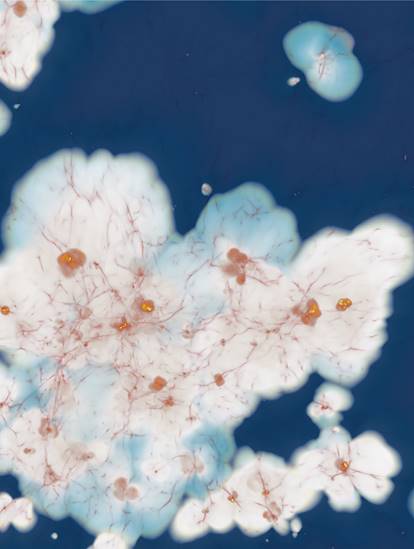New JWST low-mass galaxy observations could help settle scientific debate about early universe origins

Image: The process of reionization in numerical simulations. Credit: J. Rosdahl, H. Atek and the SPHINX project team
In summary
- International researchers have found that small galaxies are very likely at the origin of reionization
- Swinburne led the use of the James Webb Space Telescope to obtain the first spectra of very low-mass galaxies
- Their observations could help settle a long-running scientific debate about the drivers of reionization
International researchers have made a major astronomical breakthrough, revealing that small galaxies are very likely at the origin of reionization – a crucial period in the early universe where neutral hydrogen transformed into ionized gas.
A paper published in Nature has used the James Webb Space Telescope (JWST) to obtain the first spectra of very low-mass galaxies less than a billion years after the Big Bang.
Their observations could help settle a long-running scientific debate about the drivers of reionization and could be essential to understanding the formation of the very first galaxies.
Swinburne University of Technology is the only Australian university as part of the international collaboration, led by Associate Professor Ivo Labbe.
Co-author, JWST Australian Data Centre Senior Scientist, and Swinburne Laureate Postdoctoral Research Associate in Galaxy Spectral Modelling Dr Themiya Nanayakkara says he is thrilled with the outcomes of this global research involving the Paris Astrophysics Institute (Sorbonne University/CNRS), and universities in Pittsburgh and Texas.
“This work makes a strong case for smaller galaxies to be the driving force behind reionizing the universe. While the number of energetic photons produced by these small galaxies may come as a shock to many, the cosmological implications are also profound.”
Reionization, which occurred some 500 to 900 million years after the Big Bang, marks a crucial period in the history of the universe. It represents the transformation of neutral hydrogen – which predominated the universe – into ionized gas and marks the end of the ‘Dark Ages’ in cosmic history.
Scientists have been arguing what drove the reionization of the universe for a long time. Confirmation of the hypothesis relating to low-mass galaxies has proven particularly difficult, given their low luminosity.
The study achieved this technological feat through the unique combination of JWST sensitivity and the gravitational lensing effect of the Abell 2744 cluster, making nearby galaxies act like cosmic magnifiers, distorting space and amplifying the light of background galaxies.
The team wants to extend this study to a larger scale, to confirm that this location is representative of the average distribution of galaxies in the universe.
“We have now entered uncharted territory with the JWST,” says Dr Nanayakkara. “This work opens up more exciting questions that we need to answer in our efforts to chart the evolutionary history of our beginnings."
-
Media Enquiries
Related articles

- Astronomy
International team discovers the most distant spiral galaxy ever seen
Swinburne University of Technology is part of an international team that has discovered a massive, Milky Way-like spiral galaxy that formed just 1 billion years after the Big Bang, revealing an unexpectedly mature structure in the early Universe.

- Astronomy
- Technology
- Science
Swinburne’s Spotlight on STEM: A Night of Space Innovation with Shelli Brunswick
Swinburne University hosted a Spotlight on STEM event with space innovator Shelli Brunswick, exploring space technology, leadership, and career opportunities in the space industry

- University
- Astronomy
- Science
‘Big Wheel’ disk galaxy discovered accidentally by international team
An international team involving Swinburne University of Technology has discovered a giant spiral disk galaxy in the early cosmos.

- University
- Astronomy
Swinburne student presents lunar research at the 75th International Astronautical Congress
Swinburne student Erin Rose recently presented her research on lunar lava tubes at the International Astronautical Congress in Milan

- Astronomy
- Technology
- Science
Australia’s moon rover takes off with Swinburne University of Technology developing critical technology for success
Swinburne University of Technology has been selected as a research university that will deliver key technology for Australia’s first lunar rover.
-

- Astronomy
International team discovers the most distant spiral galaxy ever seen
Swinburne University of Technology is part of an international team that has discovered a massive, Milky Way-like spiral galaxy that formed just 1 billion years after the Big Bang, revealing an unexpectedly mature structure in the early Universe.
Thursday 17 April 2025 -

- Astronomy
- Technology
- Science
Swinburne’s Spotlight on STEM: A Night of Space Innovation with Shelli Brunswick
Swinburne University hosted a Spotlight on STEM event with space innovator Shelli Brunswick, exploring space technology, leadership, and career opportunities in the space industry
Friday 21 March 2025 -

- University
- Astronomy
- Science
‘Big Wheel’ disk galaxy discovered accidentally by international team
An international team involving Swinburne University of Technology has discovered a giant spiral disk galaxy in the early cosmos.
Tuesday 18 March 2025 -

- University
- Astronomy
Swinburne student presents lunar research at the 75th International Astronautical Congress
Swinburne student Erin Rose recently presented her research on lunar lava tubes at the International Astronautical Congress in Milan
Wednesday 22 January 2025 -

- Astronomy
- Technology
- Science
Australia’s moon rover takes off with Swinburne University of Technology developing critical technology for success
Swinburne University of Technology has been selected as a research university that will deliver key technology for Australia’s first lunar rover.
Tuesday 17 December 2024

